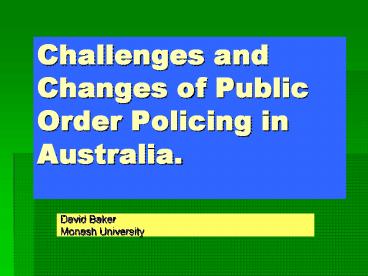Challenges and Changes of Public Order Policing in Australia. - PowerPoint PPT Presentation
1 / 12
Title:
Challenges and Changes of Public Order Policing in Australia.
Description:
Standing of police affected and often mirrored in ... 1948 St Patrick's day Bash, Brisbane. Death: rare (3 instances) ... Chris Corrigan, Patrick's Chairperson: ... – PowerPoint PPT presentation
Number of Views:170
Avg rating:3.0/5.0
Title: Challenges and Changes of Public Order Policing in Australia.
1
Challenges and Changes of Public Order Policing
in Australia.
- David Baker
- Monash University
2
1901 Federation of Australia 6 state polices
and two territory agencies (centralised,
uniformed, bureaucratic police forces) 1981
Australian Federal Police
3
- Public Order Policing some general comments
- Diverse forms of public protest
- Standing of police affected and often mirrored in
public order policing - Police mandate enforcing the law and
maintaining public order - Contemporary POP in Western world
-
minimising violence, - communication liaison,
- negotiated management,
- protest permits
4
- Traditional Policing of Industrial Confrontation
- Police, with batons, escorting strike-breakers to
the workplace ? violent confrontations - Police quelled industrial unrest
- Baton symbol of police public order might
- (NOT the gun, very rare indeed in Australia)
- Criticism of police tactics (not involvement)
that was criticised - Policing industrial disputes in Australia
- erratic pattern of intermittent violence and
oppression - no formulated policy of repression
- police actions were swift and ruthless
- legalistic and forceful
5
Failure to hold police accountable Lets
consider a few examples of police-worker
confrontation Clunes Riot 1873 1912 Black Baton
Friday, Brisbane 1948 St Patricks day Bash,
Brisbane Death rare (3
instances) 1919 Tommy Edwards, lumper at
Freemantle wharf 1929 Norman Brown, ricocheted
bullet 1928 Allan Whittaker
6
There was a chap by the name of Whitakker, he was
walking on the right-hand side of the waterfront.
He got shot right through the back of his neck.
The bullet came out through his mouth. I saw
Whitakker fall and I turned round and said, You
dirty bastards, are you fair dinkum? And I saw
the constable go like that with his revolver ----
shoot off his arm, and I got shot right through
my arm. Fellow stevedore Jim Nagel, 2 November
1928 No government inquiry, no police inquiry,
no Royal Commission Police command, government,
press supporting ruthless actions in 1920s and
1930s Police leadership conservative, hard-line,
anti-unionist, anti-worker, anti-Communist Were
police attempting to disperse the gatherings
or actions designed to teach a lesson?
7
- Modern Trends
- 4 Anti-Vietnam War Protests
- July American consulates
- Moratoriums
- La Trobe University students
- 1970s onwards
- mobile TV cameras
- mere presence of journalists
- new police leadership
- greater accountability (eg, internal
investigation units)
8
- 1990s
- Prudent approach of foregoing arrests
- Need for self-control and discipline when close
physical contact between police and protesters - More tolerant approach, under-enforcement of the
law - But significant exceptions, eg, 1993 Richmond
Secondary College baton charge - Concept of negotiated management
- Reneging on arrangements
- 1997 Canada
- 1999 New Zealand
- Police must WIN, either by force or persuasion
- In industrial disputes, hasten slowly so
parties can negotiate - Police normally have superior force and weaponry
- Specialist tactical response units
- BUT such units and technology only used on a
limited basis to date
9
1998 Australian Waterfront Dispute Rapport and
protocols developed in 1990s We were driving
through the heads of our blokes that the name of
the game isnt to whack coppers you whack
coppers you get pinched, youre not on the picket
line any more. We werent going to win picket
lines by fighting coppers what we had to do, was
play it cool. BLF organiser, John Cummins 7
April 1998 Patrick Stevedoring sacked entire
workforce (all MUA members) Federal Government
Patrick versus Maritime Union of Australia War
on the Wharves ----- volatile and symbolic test
case Daily meetings of police union
organisers Policing
peacekeeping and non-interventionist
philosophy East Swanson Dock 18 April
truce Blockades community assemblies Chief
Commissioner Comrie
10
Western Australia tactical response groups
tactical blunder 21 April State police
commissioners wanted a negotiated and
non-violent solution No further attempts or
sorties to break police lines
CRITICISMS law of
the jungle Chris Corrigan, Patricks
Chairperson I cannot remember a time when the
rule of law has been so openly flouted for such a
long period in Australia watched in dismay as
police stood a few metres away as picketers
welded steel girders into place across the road
outside East Swanson dock Police resisted
employer government pressures to smash pickets
and community protests
11
Police considered potential consequences of their
actions Some interference to company business and
some inconvenience to general public BUT a good
result for 100 days operation (Commander
Winther) Compare policing of anti-globalisation
demonstrations Overseas ---- riot technology and
weaponry Melbournes S11 (September
2000) Protesters with diverse agendas, lacking
leadership, fragmented strategies TV footage of
police aggression New Industrial Relations
legislation (2005) has virtually outlawed strike
action Will the non-confrontational and
peacekeeping approach be tested in the future?
12
- Conclusion
- Today in Australia, police keep control of
protest, mainly by persuasion and negotiation
with various groups. - Mechanisms of accountability of visible public
order policing are much broader and more
demanding of police than ever before. - There are challenges ahead in maintaining the
non-confrontation and non-interventionist
approach. - The BATON still remains the symbol of police
might IF they are to use force at public disorder
situations.

